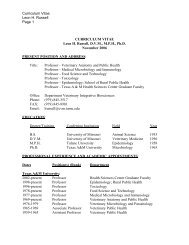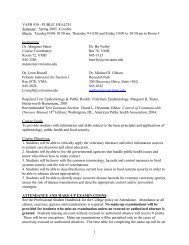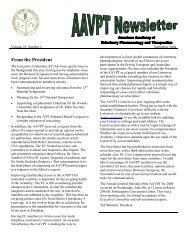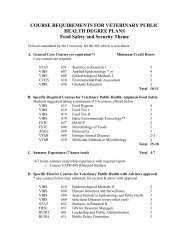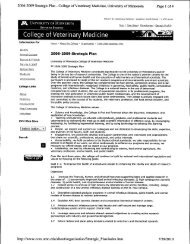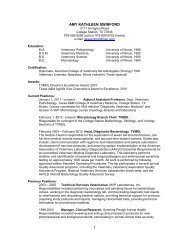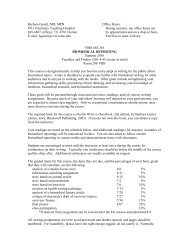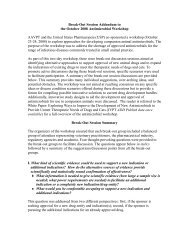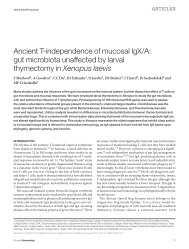Download PDF - College of Veterinary Medicine - Texas A&M ...
Download PDF - College of Veterinary Medicine - Texas A&M ...
Download PDF - College of Veterinary Medicine - Texas A&M ...
Create successful ePaper yourself
Turn your PDF publications into a flip-book with our unique Google optimized e-Paper software.
Faculty/Staff Focus<br />
Researchers greatly improve evolutionary tree <strong>of</strong> life for mammals<br />
An international research team led<br />
by researchers at the <strong>Texas</strong> A&M University<br />
<strong>College</strong> <strong>of</strong> <strong>Veterinary</strong> <strong>Medicine</strong><br />
& Biomedical Sciences (CVM) and<br />
University <strong>of</strong> California, Riverside<br />
(UCR) released for the first time a<br />
large, robust DNA matrix that represents<br />
99 percent <strong>of</strong> mammalian families<br />
and covers the deepest divergences<br />
among all living mammals.<br />
“Our study, a collaboration led by<br />
researchers at <strong>Texas</strong> A&M University<br />
and the University <strong>of</strong> California, Riverside,<br />
together with members <strong>of</strong> several<br />
international institutions, represents<br />
the culmination <strong>of</strong> a five-year project<br />
aimed at using large genetic datasets<br />
to better understand the evolutionary<br />
history <strong>of</strong> mammalian families and<br />
genera,” said William Murphy, associate<br />
pr<strong>of</strong>essor in the Department <strong>of</strong> <strong>Veterinary</strong><br />
Integrative Biosciences at the<br />
CVM, who co-led the research project<br />
with Mark Springer, pr<strong>of</strong>essor <strong>of</strong> biology<br />
at UCR. “Our findings now clarify<br />
how mammals should be properly<br />
classified, and [this research] provides<br />
us with a better understanding <strong>of</strong> the<br />
environmental and ecological basis for<br />
why mammals diversify, and a proper<br />
comparative and temporal framework<br />
for understanding the genetic changes<br />
that have led to their remarkable diversity<br />
in size and form.”<br />
Phylogeny is the history <strong>of</strong> organismal<br />
lineages as they change through<br />
Dr. William Murphy<br />
52 • CVM Today • Winter 2012<br />
time. A vast evolutionary tree, called<br />
the Tree <strong>of</strong> Life, represents the phylogeny<br />
<strong>of</strong> organisms, the genealogical<br />
relationships <strong>of</strong> all living things.<br />
Organisms are biologically classified<br />
according to a hierarchical system with<br />
seven main taxonomic ranks: kingdom,<br />
phylum or division, class, order, family,<br />
genus, and species. For example,<br />
humans are known taxonomically as<br />
Homo sapiens. Their genus is Homo,<br />
the family is Hominidae, the order is<br />
Primates, and the class is Mammalia.<br />
“To estimate when different mammal<br />
groups split, we used a ‘relaxed<br />
clock’ approach, which allows rates<br />
<strong>of</strong> DNA to change across the tree <strong>of</strong><br />
mammals,” Murphy said. “To produce<br />
reliable estimates requires that we<br />
have access to a large collection <strong>of</strong><br />
well-established fossil constraints to<br />
estimate rates <strong>of</strong> changes on different<br />
branches <strong>of</strong> the tree, and then we can<br />
convert the tree <strong>of</strong> relationships into<br />
a time tree, in which the branches are<br />
scaled in proportion to time. This time<br />
tree allows us to examine when different<br />
groups <strong>of</strong> mammals originated and<br />
diversified, and then associate factors<br />
which might have been responsible for<br />
these diversification events.”<br />
The study results appeared in the<br />
Sept. 22, 2011, issue <strong>of</strong> Science Express.<br />
“Our phylogeny, underpinned by a<br />
large number <strong>of</strong> genes, sets the stage<br />
for us to understand how the different<br />
mammalian species are related to<br />
each other,” Springer said. “That will<br />
help us understand when these species<br />
diverged from each other. It will<br />
allow us to look for taxonomic rates<br />
<strong>of</strong> increase or decrease over time in<br />
different groups in various parts <strong>of</strong> the<br />
world so that we can understand these<br />
diversification rate changes in relationship<br />
to important events in Earth’s<br />
history – such as the diversification <strong>of</strong><br />
flowering plants and changes associated<br />
with climatic events. Researchers<br />
routinely make use <strong>of</strong> phylogenies in<br />
diverse fields such as ecology, physiology,<br />
and biogeography, and the new<br />
phylogeny for mammalian families<br />
provides a more accurate framework<br />
for these studies.”<br />
“When you understand how taxa are<br />
related to each other,” Springer added,<br />
“you can start to understand which<br />
changes at the genome level underpin<br />
key morphological changes associated<br />
with, say, flight and echolocation in<br />
bats or loss <strong>of</strong> teeth in toothless mammals.<br />
In other words, you can pinpoint<br />
key molecular changes that are associated<br />
with key morphological changes.<br />
This would be extremely difficult, if<br />
not altogether impossible, without the<br />
kind <strong>of</strong> robust molecular phylogeny we<br />
have developed.”<br />
The research team looked for<br />
spikes in the diversification history <strong>of</strong><br />
mammals and used an algorithm to<br />
determine whether the rate <strong>of</strong> diversification<br />
was constant over time or<br />
whether there were distinct pulses <strong>of</strong><br />
rate increases or decreases.<br />
“For example,” Murphy said, “we observed<br />
a distinct pulse <strong>of</strong> diversification<br />
when most <strong>of</strong> the mammalian orders<br />
began splitting from one another, near<br />
the end <strong>of</strong> the Cretaceous Terrestrial<br />
Revolutions, when flowering plants and<br />
insects diversified, and also at a time<br />
when sea levels changed and continental<br />
boundaries became reorganized.”<br />
Murphy and colleagues also detected<br />
a second spike in the diversification<br />
history <strong>of</strong> mammals at the end <strong>of</strong> the<br />
Cretaceous—65.5 million years ago,<br />
when dinosaurs, other large terrestrial<br />
vertebrates, and many marine organisms<br />
went extinct, opening up a vast<br />
ecological space.<br />
“We also found evidence that the<br />
Cretaceous-Tertiary Mass extinction,<br />
which occurred 65.5 million years ago<br />
and was responsible for the demise <strong>of</strong><br />
the dinosaurs, other large terrestrial<br />
vertebrates, and many marine organisms,<br />
also promoted diversification <strong>of</strong><br />
mammals into their larger and more<br />
specialized modern forms by filling the<br />
ecological void left by the organisms<br />
that went extinct,” Murphy said.<br />
The research team also reported that<br />
their results contradict the “delayed<br />
rise <strong>of</strong> present-day mammals” hypothesis.<br />
According to this hypothesis,<br />
introduced by a team <strong>of</strong> scientists in a<br />
2007 research paper, the ancestors <strong>of</strong><br />
living mammals underwent a pulse <strong>of</strong><br />
diversification around 50 million years<br />
ago, possibly in response to the extinction<br />
<strong>of</strong> archaic mammals that went<br />
extinct at the end <strong>of</strong> the Paleocene<br />
(around 56 million years ago). The<br />
earlier extinction event around 65.5<br />
million years ago, which resulted in the<br />
continued on page 53




